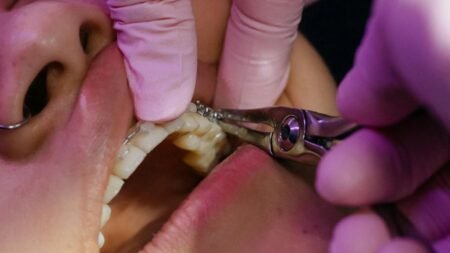When you think about improving your dental health or achieving that perfect smile, whom do you turn to? An orthodontist or a dentist? While both may seem similar, their roles, expertise, and even income differ substantially. In this comparison of orthodontist vs dentist, we’ll delve into what these differences mean for you — whether you’re contemplating a career in oral care or deciding which professional is best for your dental needs.
Can the orthodontist and dentist salary shed light on their distinct educational paths and does it correlate with the services they provide? Whether it’s understanding the dentist salary or the orthodontist salary, we uncover the nuances that set them apart and guide your choices in oral health.
From the range of conditions they treat to the intricate work that distinguishes one from the other, this insight navigates through the maze of oral health professions. It’s time to decode the essential aspects that differentiate an orthodontist from a dentist, ensuring you make an informed decision for your dental well-being or professional aspirations. Let’s bite into the details and discover how much your smile is influenced by the expertise behind it.
What Do Orthodontists and Dentists Do?
When it comes to maintaining optimum dental health and achieving a perfect smile, many people wonder whether they should consult with orthodontists and dentists. Though these professionals share the common goal of improving oral health, their areas of expertise and the services they provide can vary significantly. Here’s a closer look at what sets a general dentist apart from an orthodontic specialist and the educational pathways they follow to offer you the best in dental care.
The General Dentist: Your Go-To for Dental Health
A general dentist acts as your primary care provider in the dental domain, addressing a wide array of oral health concerns. These range from routine dental check-ups and tooth fillings to more comprehensive preventive care. As champions of dental health, general dentists take the lead in educating patients about effective oral hygiene practices and play a crucial role in early dental disease detection and management.
The Specialist Touch: How Orthodontists Enhance Your Smile
For those seeking smile enhancement, an orthodontic specialist brings a focused expertise to the table. Orthodontists delve into the intricate work of aligning teeth and jaws to forge a harmonious smile. With the use of state-of-the-art braces, aligners, and other orthodontic appliances, they correct bite issues and help straighten teeth, thereby not only improving the aesthetic aspect of a smile but also its functionality.
Educational Pathways in Dentistry and Orthodontics
Understanding the educational journey of these professionals affirms their capabilities. A general dentist typically completes a rigorous Doctor of Dental Surgery (DDS) or Doctor of Dental Medicine (DMD) program, which builds a strong foundation in general dentistry. In contrast, orthodontists continue their educational pathways beyond general dentistry. Post obtaining their dental degree, they engage in a residency specializing in orthodontics, often culminating with a Master’s degree or certificate in the field.
| Professional | Education | Specialization | Primary Focus |
|---|---|---|---|
| General Dentist | DDS/DMD | General Dentistry | Dental Health Maintenance |
| Orthodontic Specialist | DDS/DMD + Residency in Orthodontics | Orthodontics | Teeth and Jaw Alignment for Smile Enhancement |
The Training Journey:
When considering a career in dental health, understanding the training journey for both orthodontists and dentists can guide your education and career planning. The path to becoming a dentist or orthodontist involves rigorous education and hands-on experience, but each has its distinct requirements and milestones.
The first steps in the training journey to becoming a dentist include completing a bachelor’s degree, usually with a focus on sciences, followed by four years of dental school. During these formative years, you’ll delve deep into subjects such as dental anatomy, patient diagnosis, and treatment planning, along with developing your clinical skills. Once you’ve graduated and earned your dental license, your journey to provide general dental care can begin.
On the other hand, if you’re considering specializing and comparing orthodontist and dentist roles, be prepared for an extended training journey. Aspiring orthodontists are required to complete an additional 2-3 years in a demanding and specialized orthodontics residency program after dental school. Here, your training concentrates on mastering advanced orthodontic techniques, understanding craniofacial growth, and effectively diagnosing and treating complex orthodontic challenges.
To illustrate the differences, the table below compares key aspects of the training journey:
| Role | Undergraduate Education | Dental School | Additional Specialized Training | Licensing |
|---|---|---|---|---|
| Dentist | 4 Years (Bachelor’s) | 4 Years (DDS or DMD) | None | State Dental License |
| Orthodontist | 4 Years (Bachelor’s) | 4 Years (DDS or DMD) | 2-3 Years (Orthodontics Residency) | State Dental License + Orthodontic Certification |
Whether your aspirations lie in general dentistry or you’re drawn to the specialized field of orthodontics, understanding the training journey is paramount. The commitment to education and proficiency is part of the fulfillment of ensuring dental health or perfecting the art and science of a beautiful smile. As challenging as it might be, those who embark on this journey can look forward to a rewarding orthodontist vs dentist career, full of opportunities to make a significant impact on patients’ lives.
Who Do You Need?
Understanding whether to consult an orthodontist or a dentist for your oral health needs depends largely on the specific conditions treated and the required dentist services. Sometimes, your situation might benefit from collaborative dental treatments, ensuring a holistic approach to your dental care.
Conditions Treated by Orthodontists
Orthodontists are extensively trained to manage and treat various conditions affecting the alignment of teeth and jaws. They are the specialists to turn to when dealing with overcrowding, overbites, underbites, crossbites, and spacing issues. With their expertise, they can enhance both the functionality and aesthetics of your smile.
When to Visit a Dentist: Services Offered
For routine dental care and a wide range of oral health services, a general dentist is your primary contact. Whether it’s for preventive care, managing gum disease, or engaging in restorative works like fillings and crowns, dentist services ensure your teeth are healthy and your smile shines. Plus, dentists play a critical role in early detection of oral pathologies like cancer through timely screenings.
Overlap in Care: Collaborative Dental Treatments
When the boundaries of care between an orthodontist and a dentist overlap, patients receive the benefit of collaborative dental treatments. This partnership is essential especially when an orthodontic treatment plan necessitates subsequent dental procedures to fully revitalize a patient’s oral health.
Distinguishing which specialist to see can be as straightforward as comparing the conditions treated and services offered by each professional. Here’s a quick reference table to help you decide:
| Orthodontist | Dentist | Collaborative Care |
|---|---|---|
| Corrective braces | Teeth cleaning | Cosmetic restorations post-braces |
| Jaw realignment | Cavity fillings | Periodontal support during orthodontic care |
| Teeth straightening | Root canals | Joint treatment planning for complex cases |
With this knowledge, you are now equipped to make an informed decision on who to consult for your specific dental needs. Remember, maintaining the health of your teeth and gums is a collaborative effort between you and your team of dental professionals.
Orthodontist vs Dentist Salary Expectations
When considering a career path in dentistry, it’s important to understand the potential financial future you might be stepping into. Comparing the orthodontist salary versus dentist salary is more complex than looking at base numbers—it requires a deep dive into income comparison, as well as assessing the geographical variations, experience variations, and the specialization impact on earning potential. Let’s explore these variables to provide a clearer picture of what you can expect.
Comparing Income:
Historically, orthodontists have been positioned at a higher earning threshold compared to their general dentist counterparts. This is due to the additional specialized training orthodontists receive, which allows them to perform intricate procedures that general dentists typically do not. The sophistication of these treatments often correlates with a bigger paycheck. Whether you’re leaning towards a specialization in orthodontics or considering general dentistry, it’s vital to recognize how these roles differ in their earning capacities.

Geographical and Experience Variations in Salary
Where you practice can greatly influence your salary as an orthodontist or a dentist. Practitioners in bustling metropolitan areas or regions with a higher cost of living generally report higher income to mirror the economic demands of the area. In contrast, those in rural or less affluent regions may see a reflection of the lower cost of living in their salaries. Experience also plays a significant role; with each year of practice, you can see a gradual but significant increase in your earnings, especially as you build a patient base and gain reputation in your specialty.
The Impact of Specialization on Earnings
The choice to specialize is not merely a professional one but also has financial ramifications. Orthodontists, by the nature of their specialty, are often met with a salary boost due to the demand for their focused services. This specialization impact on earnings is a reflection of the additional time and investment in education, as well as the perceived value of specialized dental treatments in the eyes of patients. A high level of expertise in a niche field can thus place you in a more favorable position when it comes to your income trajectory in dentistry.
Conclusion
In the realm of oral healthcare, the distinction between orthodontist and dentist is characterized by their specialized focus and the services they provide. For your routine dental care and a broad spectrum of treatment options, a general dentist is your primary provider. In contrast, orthodontists devote their practice to the meticulous work of correcting dental and jaw misalignments, heavily influencing the aesthetic aspect of your smile. As you deliberate over your specific oral health requirements, it is vital to contemplate the intricacy of your dental condition and the level of expertise necessary to address it effectively.
Your journey to achieving optimal dental health may lead you to consult with both dentists and orthodontists to gain a comprehensive perspective on your treatment options. Understanding that salary expectations in these fields can fluctuate, it’s essential to acknowledge that factors such as geographical location, years of experience, and the extent of specialization have a tangible impact on potential earnings. This information might provide insight into the level of investment professionals in each field have committed to their craft, which in turn, could influence your choice of dental care provider.
When it comes to making the final decision between orthodontist and dentist, your individual needs and personal preferences should guide your choice. Each professional brings a unique set of skills and expertise that are suited to different aspects of oral health. The conclusion you arrive at should be a well-informed one, based on a careful evaluation of your circumstances, ensuring that you receive the most appropriate and effective dental care to meet your needs and help you maintain a healthy, confident smile.
FAQ
What is the difference between an orthodontist and a dentist?
While both orthodontists and dentists work in the field of oral healthcare, their roles and areas of expertise differ. Dentists focus on overall dental health and provide a wide range of services such as check-ups, cleanings, fillings, and preventive care. Orthodontists specialize in correcting misalignments and bite issues, using braces, aligners, and other orthodontic devices to straighten teeth and create a balanced, aesthetic smile.
What are the educational pathways for dentists and orthodontists?
Dentists typically complete a Doctor of Dental Surgery (DDS) or Doctor of Dental Medicine (DMD) degree after completing their undergraduate studies. Orthodontists, on the other hand, undergo additional specialized training after becoming dentists. They complete a residency program in orthodontics, earning a Master’s degree or a Certificate in Orthodontics.
What conditions do orthodontists treat?
Orthodontists specialize in the diagnosis and treatment of orthodontic conditions such as crowded or misaligned teeth, overbites, underbites, crossbites, and gaps between teeth. They use various orthodontic appliances and techniques to correct these issues and improve oral function and aesthetics.
What services do dentists offer?
General dentists provide comprehensive dental care for patients of all ages. They offer services such as preventive care, restorative treatments (such as fillings and crowns), gum disease management, root canal therapy, dental extractions, and oral cancer screenings. They also provide guidance on maintaining good oral hygiene.
Do orthodontists and dentists collaborate in treatment?
Yes, there is overlap in the care provided by orthodontists and dentists. In cases where a patient requires orthodontic treatment as well as restorative or cosmetic procedures, orthodontists and dentists often collaborate. This collaboration ensures that patients receive comprehensive care to address both functional and aesthetic concerns.
How do salaries compare between orthodontists and dentists?
Orthodontists generally earn higher salaries compared to general dentists. However, the precise salary figures can vary based on factors such as location, experience, specialization, and the type of practice (private practice, corporate dentistry, academia, etc.).








